Summary Bitcoin is up 145% since my last article in January 2023, but there is no mainstream media buzz or altcoin outperformance. The MVRV Z-Score suggests a neutral reading for Bitcoin's price, but historical patterns and macroeconomic signals indicate a midcycle correction. Investors should prepare for a sizeable midcycle correction and plan to scale into a broad range of Altcoins when the liquidity cycle turns. In my last two articles about Bitcoin ( BTC-USD ), I argued that it's best to buy the digital asset when things are quiet and boring ('Boredom is bullish in 2023 ' on January 17, 2023, and 'The appeal of enduring boredom ' on June 13, 2023). Since the first article of the two released in 2023, Bitcoin is up ~145%. Data by YCharts I was hoping for 'intense boredom' during 2023 with the goal of Dollar Cost Averaging back in after selling half of my position in early April 2022, and I've done that from December 2022 until late October 2023. Positioning of Author (tradingview.com) Since then, sentiment has been heating up as prices are rising. Articles about crypto are gaining more traction on Seeking Alpha, and investors are increasingly curious. However, this isn't the mania of 2021 because we haven't broken the all-time highs. There's no mainstream media buzz and no altcoin outperformance. Long-term holders of Bitcoin are not selling into speculative hands yet. 1Y+ HODL Wave / BTC price EOD (charts.bitbo.io) This article will primarily be of a technical nature, assessing possible paths forward and aiming to create realistic expectations to plan with. Technicals are subjective, and I would not act solely upon the discussed signals/patterns below discussed. However, they do provide context and a useful framework. I won't delve into detail about Bitcoin fundamentals or crypto itself, as I've covered those in past articles. If you believe Bitcoin is a pyramid scheme, a tulip mania, has no intrinsic value, etc., I'm not here to convince you otherwise. However, this is what I personally continue to believe: Bitcoin is not hard money. Bitcoin is not a currency. Bitcoin is not scalable. Bitcoin is not the Crypto Industry with all its financial schemes and irresponsible leverage. Bitcoin is a decentralized monetary debasement hedge. An opportunity to leave the vicious cycle that is the long-term debasement of the currency without the possibility of government interventions (e.g. Gold in 1933 under Roosevelt). It is no coincidence that Bitcoin appeared just after the global financial crisis, when the monetary debasement circus started getting out of hand. Bitcoin fulfilled its purpose of hedging the risks that result from monetary debasement. The tremendous drawdown during 2022 is a feature, not a bug. The liquidity cycle will turn at some point. The world isn't linear. - Nikolai Galozi, Jan. 17, 2023 Base Case: $15,000 was the (first) bottom The $15,000 mark was likely the first bottom of this cycle. Retrospectively, this should have been easy to predict, as the capitulation event coincided with the collapse of FTX. Back then, as per usual, many people were unsure about the prospects of crypto and whether the asset class would survive the heavy collateral shocks that came from the numerous bankruptcies and the historically tightening cycle resulting from the heavily rising rates on the long end of the bond market. Historical comparisons to previous cycles and the relative bottoms convinced me back then to scale back into Bitcoin, even though I was too cautious at first. MVRV Z-Score (www.lookintobitcoin.com) The MVRV Z-Score is a metric that measures the differences between market price and realized price on a Z-score basis (standard deviation metric). Historically, a Z-score of below zero was an excellent time to scale in, and a score above 4 was an excellent time to scale out of the market. Currently, at a price of $51,000, the Z-score is almost at 2, suggesting a neutral reading. Depending on the interpretation of the state of the cycle, however, a reading of two could be very bullish or quite bearish. After breaking through a Z-score of 2 during the 2021 bull run, Bitcoin then continued to rise from around $15,500 in November 2020 to $61,000 in April 2021 without any significant correction. Similarly, after materially breaking through a Z-score of 2 in December 2016, Bitcoin rose from $1,000 to a new all-time high in December 2017 of $20,000. These were the last two major bull runs of Bitcoin. On the other hand, after hitting a Z-score of around 2 in late June 2019, Bitcoin discontinued the rapid appreciation to around $13,000 and put in a second low 9 months later during the COVID-19 crash in March 2020 at around $4,000. Similarly, just ahead of the first bull run, Bitcoin hit the Z-score mark of 2 in June 2016 and rapidly declined from around $780 to around $540 within two months. It was only after these mid-cycle corrections that Bitcoin appreciated to new all-time highs. Two possible scenarios Given the outlined historical patterns, the chances for a correction after five months of straight green candles from October 2023 to February 2024 are quite high. During the last two bull runs, Bitcoin hit a Z-score of 2, started a correction, and then broke above the Z-score of 2 again to rise to new all-time highs. In 2017, Bitcoin fell approximately 40% within two months after breaking through a Z-score of 2 for the first time. This was a minor correction in the grand scheme of things, as Bitcoin was much more volatile back then. Just three months later, Bitcoin appreciated above the previous high point. Midcycle Correction 2017 (tradingview.com) In 2019, however, the correction was deeper and lasted longer. Bitcoin crashed approximately 72% during the next 8 months after initially breaking through a Z-score of 2. It took another 7 months to break above the previous high point. Midcycle Correction 2019-2020 (tradingview.com) So, which scenario of the past two cycles fits best with the current state of the Bitcoin cycle? In my opinion, the larger correction of 2019-2020 fits best, for the following reasons: 1. Bitcoin is ahead of the previous cycles. In the current Bitcoin cycle, ERA 4 (BTC mining reward of 6.25 BTC per block), the price is appreciating faster compared to the previous two cycles, ERA 3 and ERA 2. ERA 2, 3, 4 Bitcoin Halving Cycle (charts.bitbo.io) Assuming diminishing returns in the coming years (115x peak return in ERA 1 & 20x peak return in ERA 3), the current cycle will likely experience either a long period of stagnation, another correction, or a very slow-moving bull market. Put into historical context, this simply means that Bitcoin price appreciation has temporarily exceeded expectations during this cycle and suggests a high chance of consolidation over the next few months. 2. Similarities in interest rates, unemployment readings, and the yield curve: The most significant data pointing towards a larger correction are the macroeconomic recession signals. These also appeared in 2019 ahead of the bigger March 2020 correction and recession. The top during the midcycle peak in the last cycle coincided with peaking interest rates. Contrary to popular belief, sharply falling interest rates are usually bearish for risk assets as money flows from those assets into safe-haven assets such as government bonds and treasury bills, pushing rates lower. The similarities are striking: Fedfunds (blue) and BTC (orange) (tradingview.com) The yield curve is on its path to uninverting, similar to 2019, albeit with an incomparable time under inversion. The uninversion of the yield curve coincided with every recession during the last 40 years. Usually, just before the uninversion, broad markets push new all-time highs, just as they are doing now. Yield Curve US10Y-US03M (blue) & BTC (orange) (tradingview.com) The labor market is not yet signaling a recession. However, historically, the unemployment rate has always been a lagging indicator without any predictive power. The labor market showed no weakness even after the yield curve uninverted in late 2019 until it was abundantly clear that a recession was already ongoing in March 2020. The labor market usually doesn't soften slowly and quietly. In 2020, it coincided with the capitulation event, which brought down all risk assets. Unemployment rate (blue) & BTC (orange) (tradingview.com) 3. Liquidity conditions and Bitcoin dominance: Liquidity conditions remain similar to 2019, with interest rates rising and the monetary supply shrinking. The Federal Reserve Balance sheet declined during the midcycle rally of 2019, similar to what happened during the 2023 rally. In 2019, Bitcoin peaked before the Federal Reserve started to pivot. FED Balance Sheet (blue) & BTC (orange) (tradingview.com) As a function of the restrictive monetary supply, Bitcoin dominance rises. In times of low relative risk tolerance, smaller, riskier assets tend to underperform larger, less risky assets. During the monetary tightening of 2019 and 2023, Bitcoin dominance (the share of Bitcoin in comparison to the whole crypto market) rose steadily. After the midcycle top of Bitcoin, the dominance topped out, resulting from an easier monetary stance and lower interest rates, now benefiting the lower-capitalized and relatively riskier assets. BTC Dominance (blue) & BTC (orange) (tradingview.com) Strategies going forward The mentioned historical comparisons shape my expectations for likely scenarios going forward. My base case is at least a midcycle correction for Bitcoin during 2024. However, the history of Bitcoin cycles has limited utility since the asset hasn't been around for a long time. While the comparisons may seem striking at first, every cycle is inherently different. I acknowledge the uncertainty by refraining from acting on my biases about the market. Since I have a significant cash position, I won't take any profits and plan to continue Dollar-Cost Averaging if prices fall from here. I am prepared for a sizeable midcycle correction and plan to scale into a broad range of Altcoins when the liquidity cycle turns and the Bitcoin dominance peaks.












